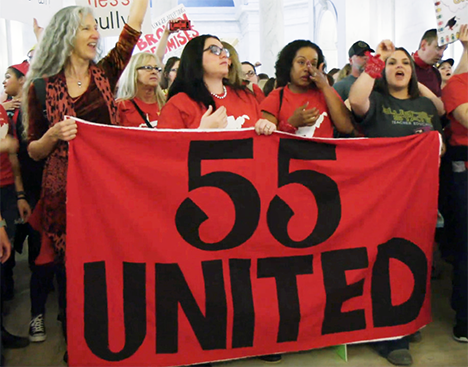CLASS DISTINCTIONS
Teachers win strike built on union solidarity and public support

West Virginia teachers celebrate after finding new ways to win
WALK THE TALK AND EVERYBODY WINS. That’s the lesson school teachers left their classrooms to teach in West Virgina in March. They taught it in just nine days.
The teachers started a statewide walkout on February 22. It was illegal. But it was worth the risk. Talking got them nowhere. They decided to take direct action.
They were the third lowest paid teachers in the USA. They wanted a raise.
The teachers also wanted more public money for schools overall. They were fed up with trying to teach in sub-standard schools with sub-standard supplies and equipment; with having to do things like use their own money to buy books and school supplies for their students.
Rebecca Diamond is a second grade teacher in Wayne County. She earns just $39,000 a year after 19 years on the job. She also works as a cashier at Hardee’s on weekends, for $8.75 an hour, to help support her family. When she started teaching, she knew it wouldn’t make her rich, “but I thought it would be enough,” she said. It isn’t. She joined the strike.
Their walkout worked. They had been told they would get nothing at all. After nine days of action they got a lot more than nothing: they got much of what they wanted for themselves and something for other government workers too.
The teachers asked for a $10,000 pay raise. They got a 5% raise of $6,100. The teachers asked for $200 million more in school funding. They got $50 million.
The teachers also won a reprieve on rising healthcare costs—for themselves and also for thousands of other public workers. They also defeated efforts to privatize schools and undermine basic workers’ rights
More an uprising than a strike
It was the unions that started the long walkout by conducting a vote and calling for the statewide work stoppage. But then it grew into something more.
“It started off with the membership following their state leaders,” said Gary Price, the superintendent of schools in Marion County. “But when their state leaders made a decision that the teachers didn’t like, they took it in a different direction.”
At that point, the course of the strike was in the hands of teachers in each of the state’s 55 counties making their own separate decisions about what to do, though they monitored the mood elsewhere over social media. One teacher started a Facebook group that had 72,000 members in three days. Their rallying cry became “55 Strong”—a reference to the enduring solidarity of all 55 school districts.

The walkout grew to include 35,000 teachers, janitors, cooks, bus drivers, and other rank-and-file school workers who took on state power: they defied laws that outlawed strikes and they rejected half-measures offered by the political establishment and cautious union leaders. They won it their way.
The teachers found ways to organize and act not found in the traditional union playbook. Teachers and service workers across the state aired their frustrations in an enormous Facebook group. Their walkout ultimately included members of three different unions and many people who did not belong to any union at all.
It wasn’t just the educators—overwhelmingly women—who stepped up. More than 1,000 students rallied in solidarity with the strikers by mounting a statewide march.
Strikers delivered meals to families whose children were dependent on food in shuttered school cafeterias, and teachers met with students preparing for college entry tests.
Parents opened up their homes to kids to keep them engaged and learning during the strike.
All capped by a rally of thousands at the state capitol, forming a sea of red shirts. When the political leaders announced a settlement, the strikers refused to leave until the agreement was sealed in writing.
That model can flummox politicians. Mitch Carmichael, the Republican president of the West Virginia Senate noted: “You’re not negotiating with a particular, a unique set of participants. There’s just this organic sort of—I don’t know what to call it. More like an uprising.”
Oklahoma next
West Virginia teachers predicted the future at their rally to celebrate their victory. They chanted: “West Virginia first. Oklahoma next.” They were right.

Lyndsey Stuart is a history teacher at Bartlesville High School in Oklahoma.
Lyndsey Stuart is a teacher in Oklahoma. She earns $34,929 a year. She’s been teaching for 10 years. She’s never had a raise. “I don’t think any teacher goes into the profession and thinks, ‘Oh my gosh, I’m going to be a millionaire,’’’ Stuart said. “But we also don’t think that we’re going to be that close to poverty.”
Oklaholma Governor Mary Fallin recently signed a bill that raises the average teacher salary by $6,100, but the teachers’ union wanted that figure to be $10,000.
Fallin also signed a bill that raises education funding by $50 million; the teachers’ union wanted that number to be higher.
The state teachers’ union in Oklahoma called for teachers to walk out of their classrooms on April 2 to demonstrate their dissatisfaction with the government’s actions. And they did. Teachers have swarmed the Capitol building in Tulsa with signs and slogans since April 2.
“I think they thought we were not going to come out in the forces that we did, especially throughout the week ... but we’re holding strong, and you don’t mess with teachers when we’re trying to fight for our kids,” Amanda Girdler, a fourth-grade teacher said.
Striking Oklahoma teachers jangled their keys and chanted “Where’s my car?” at their governor on April 4 after she compared their demands to a “teenager wanting a better car.”
Oklahoma lawmakers made plans to vote April 6 on bills that could provide another $42 million for education funding. But it’s not clear the measures will satisfy the teachers.
Teachers have complained the state’s funds aren’t enough to keep up with the cost of textbooks and supplies, and that the state hasn’t addressed issues like overly large classes.
Meanwhile in Kentucky
Thousands of Kentucky teachers stormed the state Capitol on April 2 in a unified show of support for public education. But what will happen next is not clear.
Some want to take swift, dramatic action. Others want to be cautious.
“Right now, we’re trying to get everybody’s ducks in a row,” said Nema Brewer, a Fayette County Public Schools employee who has emerged as a leader in Kentucky’s grassroots teacher movement.
Much of the debate about what to do next has played out on social media.
For weeks, teachers across Kentucky have taken to platforms such as Facebook to vent their frustrations over years of perceived disrespect toward their profession.
Some are pushing for a statewide “sickout” similar to the one that shut down nearly 30 school districts on March 30. Others are not so sure.
Brewer said similar discussions are taking place in the Facebook group she created, which, as of April 6 had more than 39,000 members.
Teachers and other public employees do not have the legal right to strike in Kentucky. But teachers are galvanized by similar movements in West Virginia and Oklahoma, Brewer said, and have taken to social media to push for more action.
Teachers and their supporters are watching to see whether Governor Matt Bevin exercises his veto power to overturn a law that would severely damage pensions for teachers.
The bill made limited changes to the pensions of current and retired teachers. However, newly hired teachers would be placed into a “hybrid” cash balance plan.
Educators and their allies said that, for decades, teachers have been willing to accept low wages and difficult working conditions on the front end because they were promised a comfortable retirement through the traditional pension system
Arizona pressure builds
Arizona teachers, among the lowest paid in the country, are threatening to strike if state lawmakers do not raise their salaries and restore dramatic funding cuts that schools have endured.
Teachers, who organized a grassroots campaign on social media, are demanding a 20 percent raise and restoration of school funding to 2008 levels. They are also asking state lawmakers to stop cutting taxes until Arizona’s per-student spending reaches the national average.

Arizona teachers showed they mean business with a “Wear red for public education” campaign
- 30 -












Add new comment